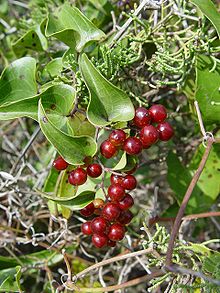Smilax aspera
| Smilax aspera | |
|---|---|

| |
| Scientific classification | |
| Kingdom: | Plantae |
| Clade: | Tracheophytes |
| Clade: | Angiosperms |
| Clade: | Monocots |
| Order: | Liliales |
| Family: | Smilacaceae |
| Genus: | Smilax |
| Species: | S. aspera
|
| Binomial name | |
| Smilax aspera | |
| Synonyms[1] | |
|
List
| |
Smilax aspera, with common names common smilax,[2] rough bindweed,[3] sarsaparille,[4] and Mediterranean smilax, is a species of flowering vine in the greenbriar family.
Description[edit]
Smilax aspera is a perennial, evergreen climber with a flexible and delicate stem, with sharp thorns. The climbing stem is 1–4 metres (3 ft 3 in – 13 ft 1 in) long.[5] The leaves are 8–10 centimetres (3.1–3.9 in) long,[5] petiolated, alternate, tough, leathery, and heart-shaped, with toothed and spiny margins. It is a monocot with reticulate venation. The midrib of the underside of the leaf is also provided with spines. The flowers, very fragrant, are small, yellowish or greenish, gathered in axillary racemes. The flowering period in Mediterranean regions extends from September to November. The fruits are globose berries, gathered in clusters, which ripen in autumn. They are initially red, later turning black. They have a diameter of 8–10 millimetres (0.31–0.39 in)[5] and contain one to three tiny and round seeds. They are insipid and unpalatable to humans, but they are a source of nourishment for many species of birds.
Distribution[edit]
This species is widespread in Central Africa (Democratic Republic of Congo, Kenya, Ethiopia), Mediterranean Europe (Cyprus, Albania, Croatia, Greece, Italy, Malta, Montenegro, France, Portugal, Spain), temperate Asia ( Israel, Jordan, Lebanon, Syria, Turkey) and tropical Asia (India, Bhutan, Nepal). It is also naturalized in other regions.[6]
Habitat[edit]
It grows in woods and scrub at an altitude of 0–1,200 metres (0–3,937 ft) above sea level.[5]
Gallery[edit]
-
Thickets of Smilax aspera
-
Smilax aspera in bloom
-
Berries of Smilax aspera
-
Leaves of Smilax aspera
-
Smilax aspera - MHNT
See also[edit]
- Smilax glyciphylla (sweet sarsaparille)
References[edit]
- ^ "The Plant List: A Working List of All Plant Species". Retrieved 6 August 2014.
- ^ BSBI List 2007 (xls). Botanical Society of Britain and Ireland. Archived from the original (xls) on 2015-06-26. Retrieved 2014-10-17.
- ^ USDA, NRCS (n.d.). "Smilax aspera". The PLANTS Database (plants.usda.gov). Greensboro, North Carolina: National Plant Data Team. Retrieved 2 February 2016.
- ^ Altervista Flora Italiana, salsapariglia, sarsaparille, rough bindweed, Smilax aspera includes photos and European distribution map
- ^ a b c d Pignatti S. - Flora d'Italia – Edagricole – 1982. Vol. III, pag. 401
- ^ "Smilax aspera". Germplasm Resources Information Network. Agricultural Research Service, United States Department of Agriculture. Retrieved 6 August 2014.
External links[edit]





